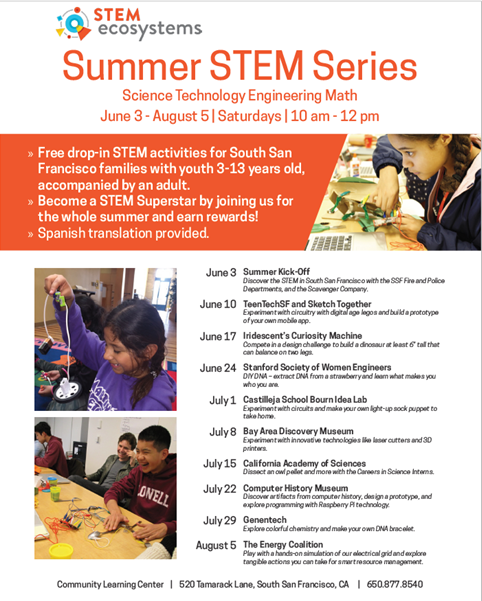South San Francisco, CA May 15, 2017 Submitted by SSFUSD
Become a STEM Superstar by joining the STEM Learning Ecosystems for fantastic STEM learning opportunities throughout the summer. The STEM Summer Series will provide free drop-in STEM learning opportunities for kids 3-13 years old – all children must be accompanied by an adult. The Summer STEM Series will take place every Saturday through the summer at the Community Learning Center, 520 Tamarack Lane, South San Francisco. Space is limited, so plan to arrive early.

About the Program
Robust STEM Learning Ecosystems have the potential to:
Seek out and successfully engage young people historically under-represented in STEM to participate in high-quality, diverse and interconnected STEM learning experiences.
Design and connect STEM learning opportunities to reflect the reality of young people’s lives: learning not just in school but out-of-school, online, home and in daily life.
Equip all STEM educators to understand the multiple learning contexts of young people and successfully lead them in active, collaborative and rigorous learning.
Provide experiences in multiple settings that enable young people to build complex skills, including how to design, test and revise solutions to real-world problems, and to work collaboratively with adults and peers.
Encourage young people to experience the joy of learning and the rewards of persistence through unhurried opportunities to tinker, experiment and explore areas of interest.
Actively engage young people in science, engineering and mathematical practices, as detailed in the Next Generation Science Standards and other similar state standards for science education and the Common Core State Standards.
Nurture young people’s “STEM identity,” or self-perception of competence in STEM. STEM Learning Ecosystems can do this by engaging them in challenging, relevant problem-solving on issues they care about; publicly recognizing them for their efforts; and helping their parents and guardians support their pursuit of and interest in STEM.
Ensure parents and guardians have the capacity to support their children’s STEM success by understanding the pathways to further STEM education and careers and accessing consistent guidance and resources.
Assess what young people know and are able to do in diverse ways that are understood and respected across settings. New assessment strategies include use of such tools as digital badges, e-portfolios or other competency-based ways they can demonstrate mastery of skills and knowledge.
Ensure young people have opportunities to meet and build mentoring relationships with STEM professionals from similar backgrounds who serve as role models. STEM Learning Ecosystems ensure that young people are taught, from an early age, about a range of STEM career possibilities.
Connect preK-12 STEM learning, in and out-of-school, to post-secondary and STEM career opportunities.
Match STEM learning pathways to the changing needs of STEM higher education and workforce.
My daughter wants to become a computer programmer.